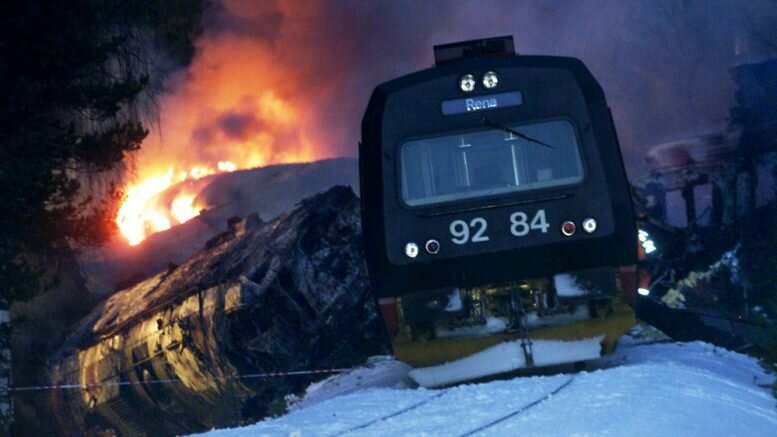Just after New Year 2000, a local train from Hamar collided with an inter-city train from Trondheim. On Saturday, January 4th, it is 20 years since 19 people died in the Åsta accident.
Following the collision at the Åsta station in Østerdalen, large quantities of diesel fuel leaked out, leading to a fierce fire. One of the survivors of the collision was Christopher Øvergaard.
He jumped out of the burning train and crawled through the forest with broken bones. Of the passengers in the wagon where he sat, he was the only one who survived, as he told in the NRK documentary “The Survivors.”
In retrospect, he remembers well how the train stood for a long time, waiting at the disused Rustad station, where there is an interchange so that the train from Trondheim could pass safely on the side. But there was no passing train.
The second largest in the post-war era
“I remember I thought we stood for a long time. Then we drove again, without having met a train. So I thought, ‘- Yes, yes, we might not meet any trains anyway,’” Øvergaard told Dagbladet.
A few minutes after his train left Rustad station, it crashed. Of the Norwegian rail accidents during peacetime, only the Thetten accident in Gudbrandsdalen in 1975 has claimed more lives than the Åsta accident. Then 27 people perished.
There were a total of 86 passengers on board in the two trains at the time of the accident. Probably 16 of those were instantaneously killed in the collision, while three died shortly afterwards.
In addition to fire crews and ambulance personnel, other passengers also contributed to the rescue work. Two Britons later received the Medal for Heroic Deeds for their efforts.
Could not happen today
The report commissioned by the Investigation Commission to the Ministry of Justice in 2000 stated that the direct cause of the accident was the failure of the signal system or human error.
Jernbaneverket was named responsible and given NOK 10 million in fines. Ten years later, the executive agency ruled that the introduction of two-way radio and automatic traffic control has made it safer to travel by train. The new safety systems mean that trains running on a red light are stopped automatically.
One of the trains ran on a red light. It was not discovered by the train manager until three minutes had passed. No sound alarm was installed that warned that two trains were on collision course. There was also no automatic train stop or train radio installed.
The only way to get in touch with the trains was by cell phone. But the numbers of the drivers and conductors of the two trains were listed incorrectly, or they were not listed at all. Thus, the manager at Hamar did not know where to call.
In connection with the 10-year mark of the accident, Director Erik Ø. Johnsen of the Norwegian Railway Authority told NTB that the greatest safety challenges for the railway today are related to two factors: level crossings and landslide problems.
Can work against its purpose
In 2010, the Support Group for the relatives after the accident held a commemorative event for the victims. Flowers were laid by the memorial stone at Åsta, and 19 candles were lit, one for each of those who perished.
In 2015, the support group leader Anstein Gimse told VG that they would not arrange any public commemoration on the 15th anniversary.
“Many people want to leave this behind now. A memorial may therefore work against its purpose for some. This year, people can mark this in their own way, as they wish,” he said.
On Saturday, January 4th, 2020, it has been 20 years since the local train from Hamar collided with the inter-city train from Trondheim at Åsta station in Østerdalen.
© NTB Scanpix / #Norway Today



Be the first to comment on "20 years since the postwar era’s second largest train accident"